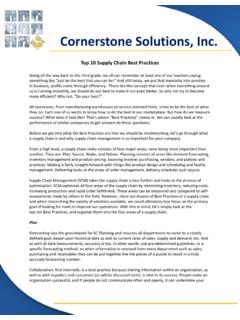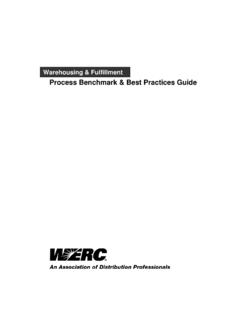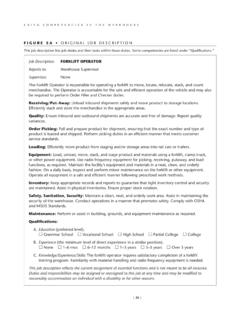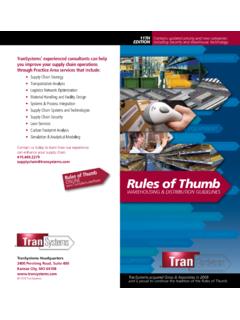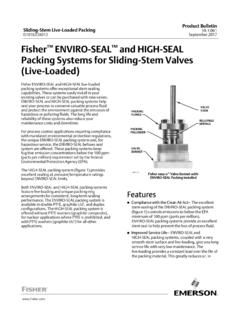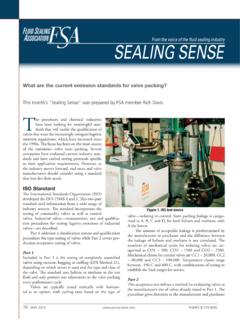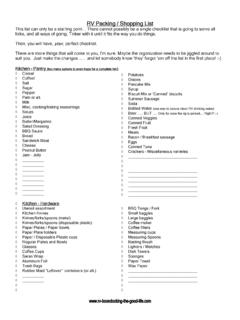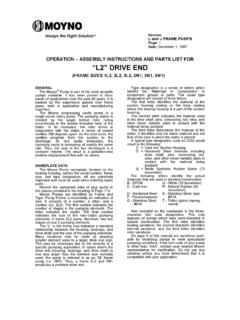Transcription of Picking and Packing - WERC
1 Best Practices Guide WERC and Supply Chain Visions, 2007. ALL RIGHTS RESERVED Pick/Pack 1 Picking & Packing Picking and Packing is the process of locating and pulling product from inventory and Packing it into shipment containers to fill a customer order. In this section, best practice attributes for the following process groups are covered: Strategy and Methods Tactics and Equipment Pick Documents Transactions Performance Strategy and Methods Assess your order profiles. The Picking process should support both customer order profiles and product activity profiles. Typically, customer order profiles, or the way customers order your product, fall into three categories: Order Mix: Understanding both the mix of high and low volume product and the percentage of order lines that use full pallets, full cartons, broken cartons, single units or some combina-tion of these, allows you to plan pick area layouts and staffing.
2 Order Size: Understanding the number of units that customers typically order allows you to set carton size or to encourage, through marketing programs and pricing, customers to order in full carton quantities. Order Lines: Understanding the number of lines in each order is important to setting Picking strategies. A warehouse with mostly single line orders vs. one with mostly multi-line orders will have significantly different pick strategies. Understanding product activity facilitates pick area layouts. It is important to review the or-der or pick frequency, how many times the product is picked, and the order volume, how much of the product is picked. Most will find their orders follow the 80/20 rule, where 80% of the or-ders are made up of 20% of the product stockkeeping units (SKUs).
3 By identifying the top 20% of products, you can define the correct Picking strategy. As your product mix changes you should review the impact on your Picking strategy. With an awareness of your product profile, an appropriate pick method or methods can be selected. Some common order management or order release methods are: Single Order Picking : The most common pick method is to pick to a single order; in this process the entire order is picked. The order may be issued to the pick area as a printed-to-a-pick list, a pick label or dropped to an RF (radio frequency) terminal. The entire order may be picked and placed directly into the shipping container, eliminating downstream handling. Typically, orders are prioritized by customer-requested ship date.
4 Multi-Order Batch Picking : Batch processes are most effective when operators have to travel long distances in the pick area. By batching a number of orders together, a picker can pull the product for a number of orders as they pass by the product s stocking location. Batch Picking works best when you have a large number of product SKUs and the products are lo-cated across a large area. Pick/Pack 2 Order Consolidation: This method groups orders by destination or by customer. This has the benefit of pulling product for multiple orders in a single pass through the pick area. Wave: A wave is an automated grouping of orders by a specific set of criteria so that these orders are released to the pick area as a group.
5 Grouping might be based on criteria such as priority orders, orders by freight carrier, order by shipment type or orders for a specific store, location or customer. The purpose is to break the day s work into manageable segments. Zone: Orders may be grouped by warehouse zone, such as single unit pick area, case pick area or bulk or pallet pick areas. In this case, an order may be split and consolidated in the shipping area. Many companies use a number of order release strategies. Most WMS systems will sup-port the above methods of order release. Tactics and Equipment Picking product tends to be the most labor-intensive operation in the warehouse. It is impor-tant to manage the flow of orders in the pick area to manage congestion and bottlenecks to optimize labor utilization.
6 When laying out the pick area, seek to eliminate non-value added steps and excess travel distances. Think about product placement: place more frequently picked product in the easiest to reach locations, between the waist and shoulder in pick racks and shelving (called the golden zone ), use storage fixtures when warranted to properly pre-sent product to pickers and locate odd-shaped, bulky or heavy product in locations that facili-tate safe handling. Proper ergonomics reduce operator fatigue and injury. The design of the pick line should support the type and volume of product you fulfill for your customers. Common examples of pick lines: Straight Line: The pick shelving is laid out in a straight line with the most popular products placed at the front of the line to reduce the travel distance for the pick operator.
7 Branch and Pick Zone: In this layout there is a center aisle or conveyor and the pick shelv-ing is placed at right angles to the center aisle. The most popular items are placed closest to the center aisle. Serpentine Line: The operator walks from row-to-row, front to back until the order is picked completely. The most popular items are placed on the front rows closest to shipping with the least popular items on the back rows. Pick to Conveyor: There are a number of variations with this layout, but essentially an order is passes down the conveyor from operator to operator, the operator will pick product in their pick zone and pass the order along until the entire order is completed. Pick-to-Light: Pick-to-light systems position lights on shelving and pick racks.
8 These lights signal the location and often the quantity of product to be picked for an order. This mix of automation and human interface greatly increases pick efficiencies and accuracy. AS/AR (Automatic Storage and Retrieval, Automated Conveyors and Automated Car-ousels: There are a number of automated or semi-automated systems that hold and move product to the operator when a customer order is entered. These systems move product to the operator so that it can be packed and shipped to the customer order. Striking a balance between manual and automated systems is the goal. It is dependant on volume, throughput requirements, order mix and available capital. Best Practices Guide WERC and Supply Chain Visions, 2007, ALL RIGHTS RESERVED Page 3 Pick Documents How a pick task is presented to the operator varies from company to company.)
9 Technology is playing an important role in changing how orders are managed in the pick operation. Some common methods used in the warehouse are: Paper Pick Tickets are the most common form of pick documentation. The order picker uses the document to determine the pick location and quantity. The operator must also verify that correct parts are picked and perform transactions. Paper pick tickets work well for many ful-fillment operations, but are prone to human error. Label Pick Documents work well in single order pick environments. They are a form of pa-per pick ticket and are used in a similar way. The added benefit is that labels are printed as part of the order release; the operator uses the label as the pick document.
10 When the order is picked into the shipping carton, it can be packed and the labels applied. The product is ready for shipping eliminating any downstream Packing steps. Hand Held RF Terminals and Portable Label Printers are used by many warehouses to aid the Picking process. A pick task is sent to the RF device and the operator picks the product. The product is validated by scanning the product barcode ID or RFID tag. At the end of the task, a shipping or consolidation label may be printed either on a portable printer or within the work area. The process can be virtually paperless. Pick-to-light allows for paperless Picking , when pick-to-light equipment is linked to the order management and inventory system.
